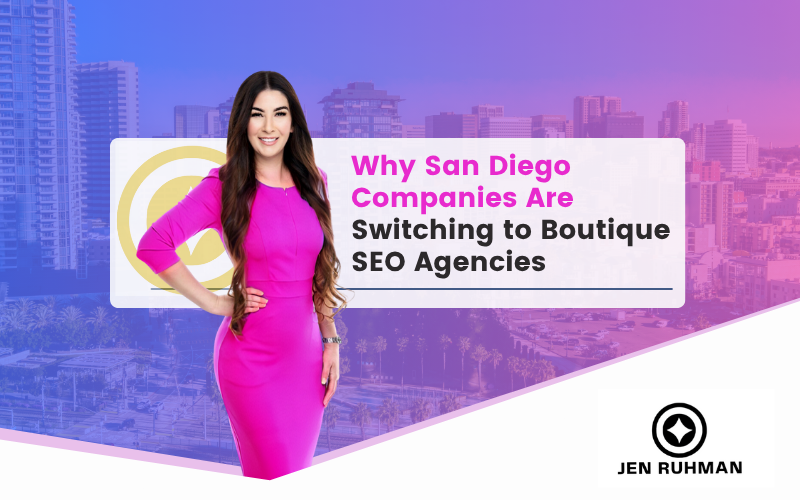
If you run a business in San Diego, you already know: we’re not competing in a sleepy town. We’re in a sunny, high-traffic, highly-searched market where everyone—from surf schools in Pacific Beach to plastic surgeons in La Jolla to med spas in Point Loma—wants to rank #1.
I’m Jen Ruhman, owner of jenruhman.com, a SEO company in San Diego, and I help local businesses get found on Google, Maps, and now AI-powered search. I’m going to walk you through the real SEO problems I see every week in San Diego—and how I fix them.
Call or text me anytime: (619) 719-1315.
Quick Summary:
Problem: San Diego businesses face heavy local competition, tourist-driven searches, and seasonal demand.
Why it matters: If you don’t localize your content and optimize for AI/SGE, bigger brands and directories will outrank you.
My solution: I use local entity signals (San Diego neighborhoods, landmarks, service areas), pre-season content, and GBP optimization to help businesses show up in Maps, organic, and AI answers.
Action: Want me to look at your site? Call/text (619) 719-1315.
Why San Diego SEO Is Different
San Diego is a little tricky for SEO because we’re serving three audiences at once:
Locals (North Park, Mission Valley, Chula Vista, La Mesa)
Tourists (Gaslamp, Little Italy, Old Town, Coronado)
Seasonal/temporary traffic (events, Comic-Con, summer rentals, wedding season)
That means one keyword like “restaurants in San Diego” can have four different intents. Google sees that—and if your site isn’t clear about who you serve, you get pushed down.
I learned this early on when I helped a local service business that kept getting traffic from tourists. Traffic looked good, but calls were down. Why? Their pages weren’t clear that they serviced San Diego County homeowners. One line changed everything.
Challenge #1: Extreme Local Competition
This is the biggest pain point.
San Diego is full of people who start businesses. That’s good for the city, not great for your rankings.
Everyone wants to rank for “San Diego + service”
Everyone wants “near me”
Everyone wants the same GMB category
Some businesses run Google Ads + SEO + Local Service Ads
So the top of page 1 gets crowded—fast.
What makes it worse?
A lot of businesses copy each other’s keywords. So Google sees 20 pages that look the same. When that happens, Google isn’t impressed. It just ranks the brand with better authority, reviews, and local signals.
How I fix it
I don’t try to win with just one keyword. I build layers:
Main page: “[service] San Diego”
Supporting pages: “[service] La Jolla,” “[service] North Park,” “[service] Chula Vista,” “near Balboa Park,” “near Mission Bay”
Blog content: homeowner, tourist, or event-based topics
This tells Google: this is a real local business that actually works in San Diego.
This is how I help clients outrank bigger sites—even Yelp sometimes—because Google likes relevance + proximity + authority, not just brand size.
Challenge #2: Seasonal & Tourism-Driven Traffic
San Diego gets a tourism wave almost every year. Summer, spring break, conferences, sports, Del Mar Fair, Comic-Con—people come here. That means queries go up in specific months.
But a lot of local businesses publish content during the season, not before it.
What happens then?
You publish in July.
Google indexes it in August.
The traffic comes in September.
But your customers were searching in May/June.
You were too late.
How I fix it
I build pre-season content calendars.
Publish spring break content in February.
Publish summer content in April.
Publish holiday content in October.
Publish “wedding in San Diego” content in January.
Publish “winter maintenance in San Diego” content in September.
San Diego might look like it has no seasons, but our searches are seasonal.
Challenge #3: Weather-Influenced Buying Habits
This is very San Diego.
Because we don’t have harsh winters, people delay buying decisions. Roof repairs, landscaping, exterior painting, even beauty treatments—people feel like they can “wait.”
So traffic is spread out, and CTR can be lower.
How I fix it
I use event-based SEO and Google Business Profile posting:
“Before summer hits in San Diego, book your duct cleaning.”
“Storm season is coming—check your roof.”
“Spring training for your dog in San Diego.”
“Before the beach crowds hit…” (for medspas, salons, spray tanning, wedding beauty)
That little nudge turns “I’ll do it later” into a call.
Challenge #4: Competing With Big Directories
If you’re in hospitality, home services, restaurants, or attractions—you’ve seen this:
Yelp
TripAdvisor
Thumbtack
HomeAdvisor
Even “Visit San Diego” sites
These sites love San Diego searches because they make money on traffic.
How I fix it
I don’t try to outrank them for everything. I make you impossible to ignore for branded and hyperlocal searches.
So instead of only chasing “San Diego restaurant,” I also optimize for:
“Best Chinese restaurant in Chinatown San Francisco” — (I know, not SD, but same logic you can apply to “best taco shop in Point Loma”)
“Seafood restaurant near Shelter Island”
“Dog trainer in Mission Hills”
“San Diego med spa Point Loma”
“Balboa Park area [service]”
“Pacific Beach [service] with parking”
When your site has those details, Google treats you as an entity, not just a page. That’s how I build authority as a SEO expert in San Diego.
Challenge #5: Weak Local Signals on the Website
A lot of San Diego business sites look like they were written for “any city.” No neighborhoods, no local events, no local wording.
Google can tell.
What I look for
Do you mention San Diego County?
Do you list service areas like Chula Vista, La Jolla, Mira Mesa, Clairemont, Scripps Ranch, Carlsbad?
Do you mention local landmarks (Balboa Park, Mission Bay, Petco Park, Liberty Station)?
Do you have a local phone number? (You do ✅)
Do you embed a Google Map?
Do you have local reviews?
How I fix it
I add entity-based local relevance throughout the site:
“We proudly serve homeowners in Point Loma, Pacific Beach, Clairemont, and the greater San Diego area.”
“Located minutes from Balboa Park.”
“Serving businesses along Morena Blvd, Sports Arena Blvd, and the Harbor area.”
This is how I help pages rank for “SEO company San Diego” and not just “SEO services.”
Challenge #6: Not Optimizing for AI Search and SGE
SGE (Google’s AI-generated results) is starting to pull in short, clear, fact-based content.
If your content is vague, too salesy, or buried in fluff—it won’t be pulled.
How I fix it
Add short, bolded summaries (like I did at the top)
Add FAQs that answer in 1–2 sentences
Use location in the answer
Structure content with H2s/H3s
Use schema at the bottom of the page
Keep the tone natural (like I’m talking right now)
That way, when someone searches “best SEO company in San Diego for small business”, we increase the chance your answer gets surfaced.
Challenge #7: DIY or Copy/Paste SEO
San Diego is full of smart business owners. I love that. But a lot of people try to do SEO themselves using generic checklists written for national brands.
That doesn’t work here.
Why?
We have hyperlocal intent
We have tourist intent
We have Spanish-speaking audiences
We have military families relocating
We have high-income coastal neighborhoods
We have service-area businesses that don’t want their home address public
That’s why one-size-fits-all SEO fails.
What a Real San Diego SEO Strategy Looks Like (How I Do It)
Here’s my general approach when a local business hires me:
1. Local Service Pages
I create or clean up pages like:
“Roof repair San Diego”
“Dog training San Diego”
“Med spa Point Loma”
“IV therapy San Diego”
“Mortgage broker San Diego”
Each one scoped for a neighborhood or audience.
2. Google Business Profile (GBP) Optimization
I post like it’s social media.
Seasonal promos
New photos (Google loves fresh San Diego photos)
Service updates
Service areas
3. Content for Locals + Tourists
“Things to do near Petco Park” (for restaurants, tours)
“Where to stay in Mission Bay”
“Best wedding photo locations in San Diego” (for photogs, salons, med spas)
“Moving to San Diego? Here’s what to know” (for mortgage, realtors, contractors)
4. Strong Internal Linking
I add anchor text like:
“SEO company San Diego”
“SEO expert in San Diego”
This tells Google exactly what I want to rank for.
Why You Can Trust This
I’ve worked with San Diego businesses across:
Beauty and medspa
Restaurants and specialty Chinese cuisine
Mental health and IOPs
Mortgage and real estate
Dog training and pet services
Commercial cleaning
I’ve seen rankings drop after Google updates, and I’ve seen them come back after adding local relevance, better content, and stronger links. I don’t test this in theory—I do it on real San Diego sites, every month.
Ready for Real Local SEO?
If you read this and thought, “Yep, that’s exactly what’s happening to me,” then let’s fix it.
Call/text me: (619) 719-1315
Visit: jenruhman.com
Let’s make your site the one that shows up when people search from La Jolla, North Park, Downtown, or Coronado.
When you work with me, you’re not getting a random SEO package. You’re getting a real human who lives here, drives past your business, knows our market, and actually cares if you get leads.
San Diego SEO isn’t “hard”—it’s just crowded. If you don’t send Google strong, clear, local signals, it will rank the sites that do. The good news? Most businesses aren’t doing this right. That leaves you an opening.
Start with:
Strong local pages
Consistent GBP posts
Seasonal/tourism content
Entity-based local relevance
AI/SGE-friendly formatting
And if you want me to do it for you, you know where to find me.
Call/text: (619) 719-1315.
FAQs
1. Why is SEO so competitive in San Diego?
Because we have a large population, tons of small businesses, and a big tourism industry. That means more people want to rank for the same keywords.
2. How long does it take to rank locally in San Diego?
Most local sites can see movement in 60–90 days if the on-page SEO, Google Business Profile, and content are set up correctly.
3. Do I really need separate pages for different San Diego neighborhoods?
Yes. Google likes location-specific content. Pages for La Jolla, Pacific Beach, or Chula Vista help you show up for people searching from those areas.
4. Can you help me show up in AI search (SGE)?
Yes. I format content to make it easier for Google’s AI to pull your answers. That includes short summaries, FAQs, and schema.
5. How do I get started with you?
Call or text me at (619) 719-1315 or visit jenruhman.com and tell me what you’re trying to rank for. I’ll tell you the fastest path.

